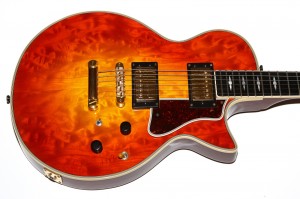
Nightbirds come in a dizzying array of colors, configurations, and models, and it can be quite difficult to discern the difference between a Nightbird, a Nightbird I, a Nightbird II, and so-on. Having gone through this pain myself and having collected a fair bit of information, I have put it all into a hopefully easy to digest article that should help you if you find yourself considering the purchase of one of these fine instruments.
Fair Warning
The information in here has been collected by me over many years as well as from the sources listed at the end of the article. Any mistakes in this page are mine, and some of the information is based solely on observations and therefore cannot be considered fact. Compiling information in this way is kind of like writing the recipe for a cake by watching 50 other people bake a cake; the recipe will probably be good, but since you didn’t have access to the original 50 recipes, it might be a bit off here and there.
Also, many Nightbirds seem to have been either custom ordered or altered over time, so just because the catalog says something like “EMG Pickups” doesn’t necessarily mean that the model in question will only be found with EMG pickups.
Nightbird
The original Nightbird is usually seen with a carved spruce top and Kent Armstrong pickups, though EMG and other pickups were an option as were some beautiful maple tops like the one shown here. The primary way to identify one of the first series of Nightbirds is the fact that they have fat slotted diamond inlays and the truss rod cover says Nightbird GG with the GG in script. GG stands for George Gruhn who was one of the main people responsible for the design. The guitar shown here is a Nightbird with the fatter inlays and Nightbird GG on the truss rod cover, with what is obviously the maple top option. The pickups shown are Kent Armstrongs (EMGs always say EMG on them). Tuners started as Gotoh wafflebacks but changed to Grover Rotomatics at some point.
| Years | 1985-1986 |
| Construction | Chambered. Mahogany back and neck |
| Top | Spruce (Maple option) - Carved |
| Binding | Body, neck, headstock, and pick guard |
| Purfling | 7-Layer: body, headstock, and pick guard |
| Trussrod Cover | Nightbird GG |
| Fretboard | Bound Ebony |
| Inlays | Fat Slotted Diamonds |
| Pickups | Kent Armstrong, EMG or HB1 options |
| Tuners | Gotoh Wafflebacks or Grover Rotomatics |
| Hardware | Gold Mueller |
| Controls | Vol/Tone, Phase, Coil Spit as option |
Though most Nightbirds are fabulous guitars, the original Nightbird is the one that started it all. They tend to be expensive, but the high quality, killer looks, and amazing playability makes them worth every penny if you can find one.
By the way, take a careful look at the bridge and tailpiece on the example shown here. I call them Mueller bridges and tailpieces in the tables because they were made by Mueller (clever, no?) but I’ve not seen them on many other guitars.
Based on the often incorrect Guild serial number charts, around 324 original Nightbirds were made making them the most common of the variants. The serial number prefix for original nightbirds is BL1xxxxxx and the range reported on the charts indicates the following dates of manufacture:
1985: BL1000001 – BL100104 (104)
1986: BL1000105 – BL100324 (219)
Nightbird I
See my detailed review here: Guild Nightbird I
In 1987 Guild changed up the Nightbird and split it into two models: The Nightbird I and the Nightbird II. The Nightbird I is the “entry level” Nightbird with a carved spruce top, chrome hardware, and an unbound rosewood fretboard while the Nightbird II is the upscale model with high-level appointments like the original Nightbird (see next section). The price guide shows no option for a maple top on the Nightbird I.
The Nightbird I is a great guitar and offered most of the Nightbird experience at a lower price since it was devoid of much of the original Nightbird’s bling. The 1987 price guide lists the Nightbird I at $795 (up to 995 later that year) with the case an extra $150.
| Years | 1987-1988 |
| Construction | Chambered. Mahogany back and neck |
| Top | Spruce |
| Binding | Body only |
| Purfling | 7-layer, body only |
| Trussrod Cover | Blank |
| Fretboard | Unbound Rosewood |
| Inlays | Dots |
| Pickups | Dimarzio (varies) |
| Tuners | Grover Rotomatics |
| Hardware | Chrome Mueller |
| Controls | Vol/Tone, Phase, Coil Spit as option |
The quick way to identify a Nightbird I is the spruce top and unbound rosewood fretboard. The simple dots are also a significant diversion from most other Nightbirds. Note that the pickups on the models I’ve seen are Dimarzio with plain black covers that make them look like the Kent Armstrongs on the original Nightbirds.
Based on the often incorrect Guild serial number charts, around 100 Nightbird Is were made, though the veracity of the charts when it comes to Nightbird Is may be suspect. I’ve only ever seen Nightbird Is with BCxxxxxx serial numbers (including the data from the Nightbird Pages), but that only covers about 10 guitars so my data is by no means complete. The reason I bring this up is because if there are indeed two prefixes, then there would be 186 Nightbird Is out there and not 103. This is one of those areas where we just need to wait for Hans’ next book.
The serial number prefix for Nightbird Is is shown to vary by year as BE1xxxxxx (1987) and BCxxxxxx (1988) though again I suspect that this may be a typo. The range reported on the charts indicates the following dates of manufacture:
1987: BE1000001 – BE100083 (83)
1988: BC1000001 – BC100103 (103) or possibly (20)
Again, take this data with a grain of salt since I can’t confirm the change in serial number prefix.
Nightbird II
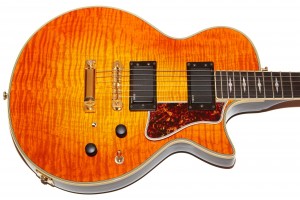
The price for the Nightbird II in January or 1987 was $1195 with the maple top listed as a $100 up-charge. The case was shown as a $150 extra. In September 1987, the price is shown simply as $1395.
| Years | 1987-1989 |
| Construction | Chambered. Mahogany back and neck |
| Top | Spruce (Maple option) - carved |
| Binding | Yes: body, neck, and headstock |
| Purfling | 7-Layer: body, headstock, and pick guard |
| Trussrod Cover | Blank |
| Fretboard | Bound Ebony |
| Inlays | Thin Slotted Diamonds |
| Pickups | EMG or HB1 option |
| Tuners | Grover Rotomatics |
| Hardware | Gold Nightbird |
| Controls | Vol/Tone, Phase, Coil Spit as option |
As a fun aside, these Nightbirds (like the original) have binding on the pick guard.
Based on the often incorrect Guild serial number charts, around 203 Nightbird IIs were made. The serial number prefix for original nightbirds is BL1xxxxxx and the range reported on the charts indicates the following dates of manufacture:
1987: BL1000325 – BL100426 (101)
1988: BL1000427 – BL100489 (62)
1989: BL1000490 – BL100530 (40)
Notice that the Serial numbers appear to continue from the original Nightbird the year before lending credence to this being the “real” Nightbird for this time period.
Nightbird ST (Standard)
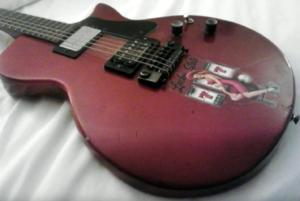
You’ll notice that this is not my pic. It’s a screen capture from Iron Mike Norton’s video on YouTube and the reason for that is that this is the only Nightbird ST that I’ve ever seen.
The description in the catalog from 1990 states that the Nightbird ST has a solid poplar body and a mahogany set-neck. The bridge is an ugly Schaller wraparound affair that seems to do the job pretty well despite it’s less than elegant appearance. The catalog reports that the Nightbird ST came with two Dimarzio pickups, both of which were swapped on Iron Mike’s guitar.
| Years | 1990-1991 |
| Construction | Solid Poplar, Mahogany Neck |
| Top | Flat |
| Binding | None |
| Purfling | None |
| Trussrod Cover | Nightbird |
| Fretboard | Unbound Rosewood |
| Inlays | Dots |
| Pickups | Dimarzio |
| Tuners | Black Gotoh Waffleback |
| Hardware | Schaller Wraparound Bridge |
| Controls | Vol/Tone |
Based on the often incorrect Guild serial number charts, exactly 20 Nightbirds STs were made of which only four were made in 1991 with the other 15 having been made in 1990. The serial number prefix for Nightbird STs is LBxxxxxx and the range reported on the charts indicates the following dates of manufacture:
1990: LB000001 – LB000015 (15)
1991: LB000016 – LB000020 (4)
According to Iron Mike’s video, the guitar has a belly cut and a forarm bevel (both of which can be plainly seen in the video), but otherwise the guitar is pretty darn simple. If you’ve got one or have seen one, please do let me know!
Nightbird DX (Deluxe)
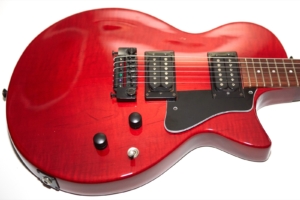
Aside from the carved maple top, the Nightbird DX appears to be the same guitar as the Nightbird ST. The pickups in mine are Dimarzios and appear to be original.
| Years | 1990-1991 |
| Construction | Poplar back, Maple Top, Mahogany Neck |
| Top | Maple - carved |
| Binding | None |
| Purfling | None |
| Trussrod Cover | Nightbird |
| Fretboard | Unbound Rosewood |
| Inlays | Dots |
| Pickups | Dimarzio |
| Tuners | Black Gotoh Waffleback |
| Hardware | Schaller Wraparound Bridge |
| Controls | Vol/Tone |
The only other Nightbird DX I’ve ever seen was this blue one listed on Reverb in the UK. Sadly, though I offered repeatedly to buy it, the seller simply would not ship to the US. That blue Nightbird DX is very appealing to me because it has Guild HB1 pickups and regular Nightbird hardware along with Guild G-shield knobs. If you own this guitar, please sell it to me. I just love blue guitars.
Based on the often incorrect Guild serial number charts, exactly 20 Nightbirds DXs were made of which only four were made in 1991 with the other 15 having been made in 1990. The serial number prefix for Nightbird STs is LCxxxxxx and the range reported on the charts indicates the following dates of manufacture:
1990: LC000001 – LC000015 (15)
1991: LC000016 – LC000020 (4)
Note that this is the exact same ratio as the Nightbird ST.
My review of a Guild Nightbird DX can be found here.
Nightbird CU (Custom)
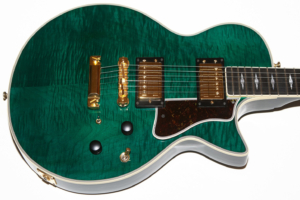
The Nightbird Custom is chambered with the mahogany back and all of the bling of the previous high-end instruments with the two that I’ve seen personally finished in very stunning green (shown) and red. The 1990 catalog lists the available colors as Cherry Sunburst, Amberburst, and Black so I don’t know if the green and red was a later year color or a special order.
| Years | 1990-1992 |
| Construction | Chambered. Mahogany back and neck |
| Top | Maple - carved |
| Binding | Body, neck, headstock, and pick guard |
| Purfling | 7-Layer: body, headstock, and pick guard |
| Trussrod Cover | Nightbird |
| Fretboard | Bound Ebony |
| Inlays | Thin Slotted Diamonds |
| Pickups | EMG |
| Tuners | Grover Rotomatics |
| Hardware | Gold Mueller |
| Controls | Vol/Tone, Phase, Coil Spit |
Based on the often incorrect Guild serial number charts, only about 101 Nightbird Customs were made and this is the only model from the three nightbirds introduced in 1990 (ST, DX, CU) that continued to be made into 1992. The serial number prefix for Nightbird STs is BL1xxxxx (continuing from the Nightbird II) and the range reported on the charts indicates the following dates of manufacture:
1990: BL100531 – BL100597 (66)
1991: BL100598 – BL100626 (28)
1992: BL100627 – BL100634 (7)
I’ve owned a fair number of Nightbirds and the Nightbird Customs that I’ve seen have all been some of the best of the bunch.
X2000
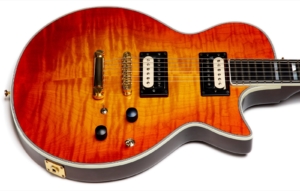
I’ve updated this page because I now own an X2000 which is shown here. The main differentiator appears to be the transition away from the slotted diamond inlays over to the more Guild-esqe inlays found on such well-known high-end guitars as the Guild D55 and JF65 acoustics.
Of the very few X2000s I’ve seen online, none of them had pick guards and none appeared to have a pick guard mounting hole in the top so my assumption is that they either didn’t come with a pick guard, or came with one uninstalled.They also commonly don’t have traditional Nightbird hardware and I’ve seen many with zebra pickups. The reasons for this will be made clear in my Nightbird X2000 review.
| Years | 1992-1993 |
| Construction | Chambered. Mahogany back and neck |
| Top | Maple - carved |
| Binding | Yes: body, neck, and headstock |
| Purfling | 7-Layer: body, headstock, and pick guard |
| Trussrod Cover | X-2000 |
| Fretboard | Bound Ebony |
| Inlays | Guild Abalone V |
| Pickups | HB1 |
| Tuners | Grover Rotomatics |
| Hardware | Gold Mueller |
| Controls | Vol/Tone, Phase, Coil Spit as option |
The Guild serial number chart shows that the X2000 and X4000 share serial number prefixes, but I can’t confirm this because the few X4000s I’ve seen have serial numbers with the prefix FFxxxxxx which the Guild chart lists as Prototype. Meanwhile, the X3000 Nightingales (see below) I’ve seen have serial number prefixes of CLxxxxxx leading me to think that it the X3000 shares its prefix with the X2000 either instead of or in addition to the X2000.
Because the X2000 and X3000 (I assume) shared the serial number prefix, there is no way for me to know how many X2000s were built, but even combined there appear to be only about 54 of both ever made. Note that these are also the first high-end Nightbirds to change the serial number prefix which had always been BL1xxxxxx.
The serial number prefix for the X2000/X3000 (I believe) models is CL000000 and the range reported on the charts indicates the following dates of manufacture:
1992: CL000001 – CL000053 (53 of both)
1993: CL000054 – CL000054 (Only one – don’t know which)
The X2000 is a fabulous and relatively rare addition to the Nightbird family, If you’ve got one or know where one is, please do let me know!
Nightingale, X040, and the X-3000
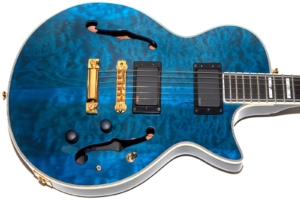
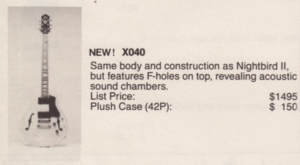
I believe the odd X040 model number is an internal factory number used before they came of with the nifty Nightingale name. Source.
In the 1988 price list it’s shown as the Nightingale and specifically mentions a spruce top and EMG pickups for the same price as it was listed for in 1987. I don’t recall seeing either of these models with anything other than a spruce top. In 1989 the Nightingale is missing from the price lists and in 1990 all of the Nightbirds are gone as well.
In 1992 the X3000 makes its debut along with the aforementioned X2000 and a very rare X4000 which I will review at some time in the future. The blue guitar at the top of this section is actually an X3000 and is possibly one of only three known to exist, the other two being similarly stunning in appearance. This is tough to believe since the X3000 stayed in the price list until 1993, but stranger things have happened in the world of rare Guilds.
The often incorrect serial number chart doesn’t list X040 as a separate model, and shows none made for the X3000, but for “Nightengale” it shows a total of 82 made. What’s the accurate number? We’ll have to wait for Hans’ next book for verification.
Miscellaneous Notes
- The Nightbird, Nightbird II, and Nightbird Custom (CU) all share the same serial number prefix of BL1xxxxx making it appear that they’re all of the same type, which they certainly appear to be. Sadly, this also make it even more confusing when trying to figure out what you’re looking at.
- Please take any and all “only xx ever made” claims with a grain of salt – even the ones on this page. Guild serial number charts are notorious for containing errors and those errors are often stated as fact. That’s while you’ll see me say being a big vague when stating how many of each model were made.
- Every Nightbird I’ve handled has had a 1 11/16″ or slightly wider neck. Some are thicker than others, but none of them ore overly thin except for the Nightbird I that I had which was shredder thin.
- From what I understand, Guild HB1 pickups were always an option even on guitars listed as having EMGs, but I don’t have that in writing anywhere
- Remember that there are a LOT of variations on the Nightbird theme out there and you may encounter one that’s similar but doesn’t exactly match any of them. The Lava-burst example at the top of the page is one such example.
- Nightbirds rock and I want them all
Sources
Hans Moust: I have learned much of what I know from a variety of sources, but the first person I have to acknowledge when it comes to anything Guild-related is Hans Moust, author of The Guild Guitar Book. No one knows more about Guild than Hans and much of what I know is thanks to him. There’s only so much he will share since he’s writing a new book that covers this era of Guild, though, so any mistakes I made are my own and have no reflection on Hans.
The Nightbird Pages: The now defunct Nightbird Pages was a great source of information about Nightbirds that has sadly gone the way of many early personal pages on the Internet. I managed to contact the owner who graciously transferred his files to me. I had hope to reinstate those pages which I may eventually do, but the source files are hard to manage having been written in software that no longer exists.
The Guilds of Grot: Kurt over at the GuildsOfGrot.com is a collector of Guilds that makes my obsession look like a passing phase. He has well over 100 Guilds, damn-near all of them mint, and the stories of acquisition to go with them all. He also has a fabulous collection of catalogs and price lists that he’s shared with me over the years that has made much of my research possible.
Guild Serial Numbers: The serial number chart that I malign repeatedly can be found here.
Books: More information on the books I reference can be found in my GAD’s Guitar Review Standards article.
Conclusion
So, what’s up with that lava-burst Nightbird from the top of the post? Here it is again in all its glory. First, let’s identify it. It’s got thin slotted diamonds and it says Nightbird on the truss-rod cover. That probably would make it a Nightbird Custom (It’s not blank and it doesn’t say Nightbird GG or have fat inlays). The problems with this guitar are the tuners which don’t match any of the ones on our lists (though do appear on the picture in the 1990 catalog), and the bridge and tailpiece which are not Nightbird parts.
According to Hans this guitar is a bit of an oddity and may have been made by an employee from parts or something else entirely. Heck, when I got it the pickups in the guitar (Fender HB1s) didn’t even exist when the serial number indicated the guitar was built. This guitar is absolutely stunning to look at and to play, but the parts on it make it not quite right. If you’re a collector, that stuff matters, but it just goes to show that all those little details add up. Does it matter in the end if the guitar plays great? It might if you’re paying for a 100% original mint Nightbird.
How about this one?
That’s a beautiful Nightbird with all the right parts with a Nightbird GG truss rod cover and is indeed one of the first run Nightbirds. I own this guitar and play it often but the pictures still make me drool.
Hopefully this helps with your quest for the perfect Nightbird. If you have any questions I’m happy to help, and if I don’t know the answer I’m happy to redirect you to someone who probably does.
Donate: PayPal Crypto:
ETH: 0x0AC57f8e0A49dc06Ed4f7926d169342ec4FCd461
Doge: DFWpLqMr6QF67t4wRzvTtNd8UDwjGTQBGs

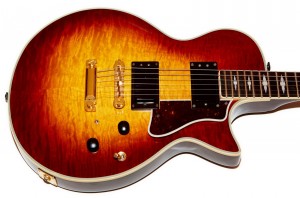
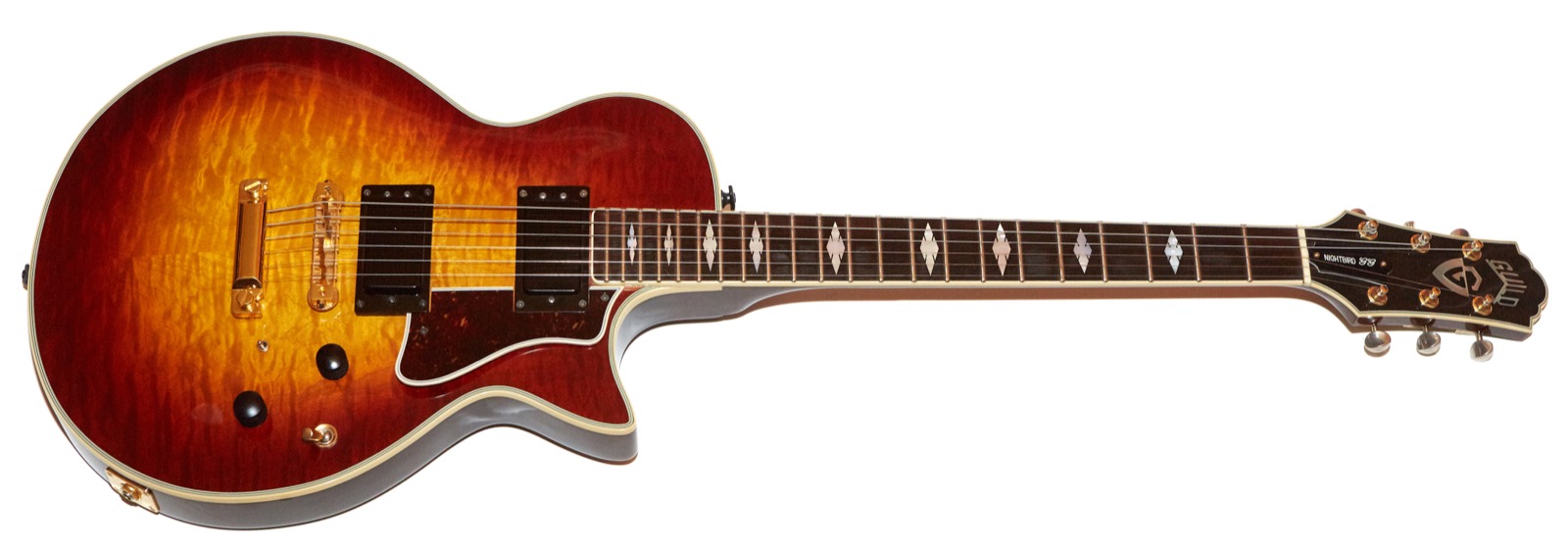
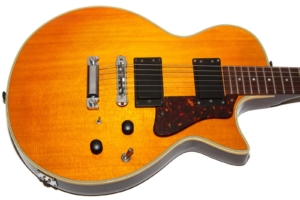
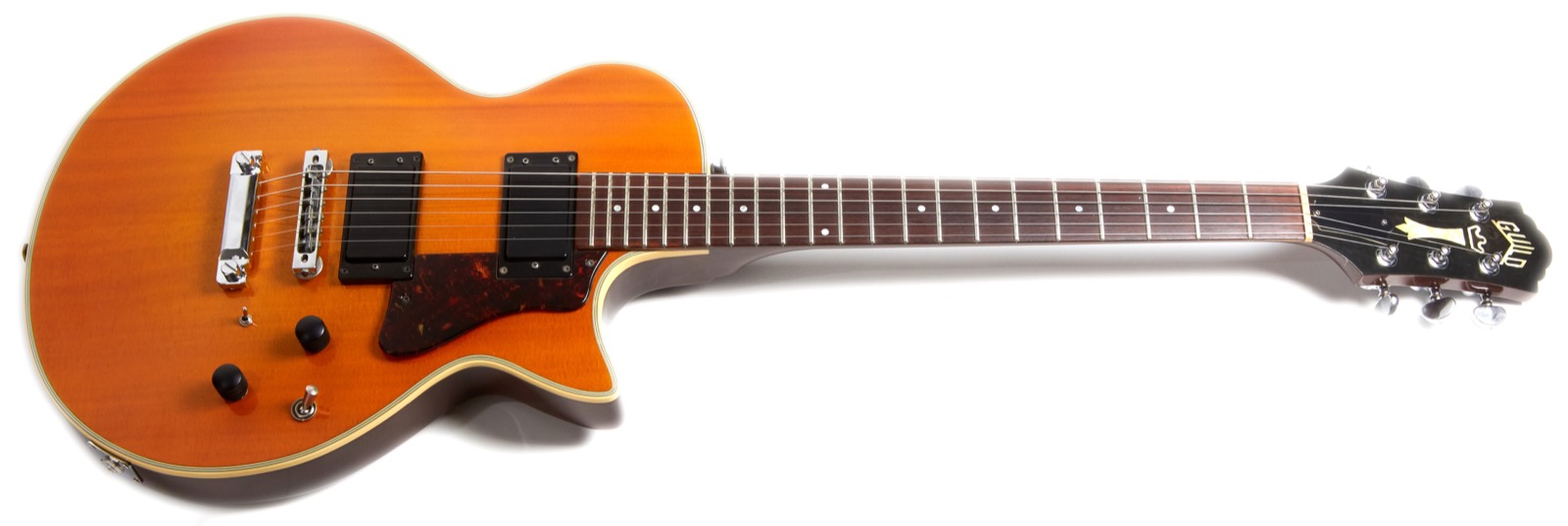
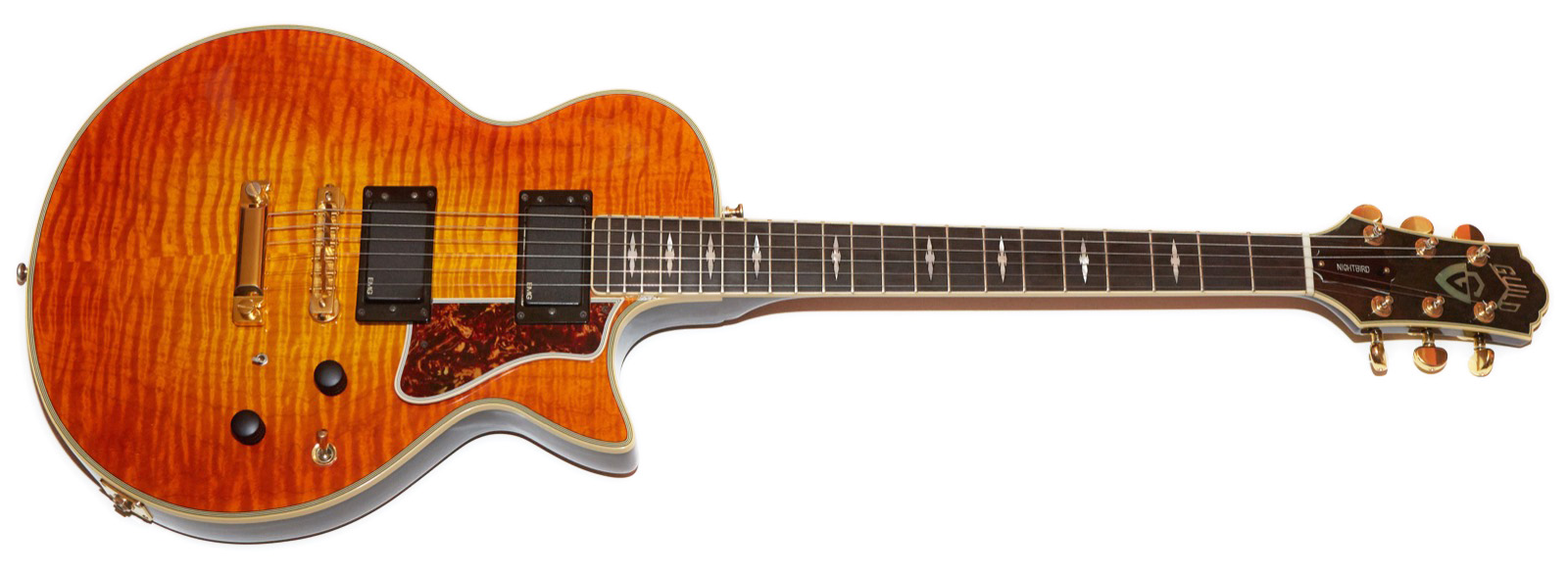

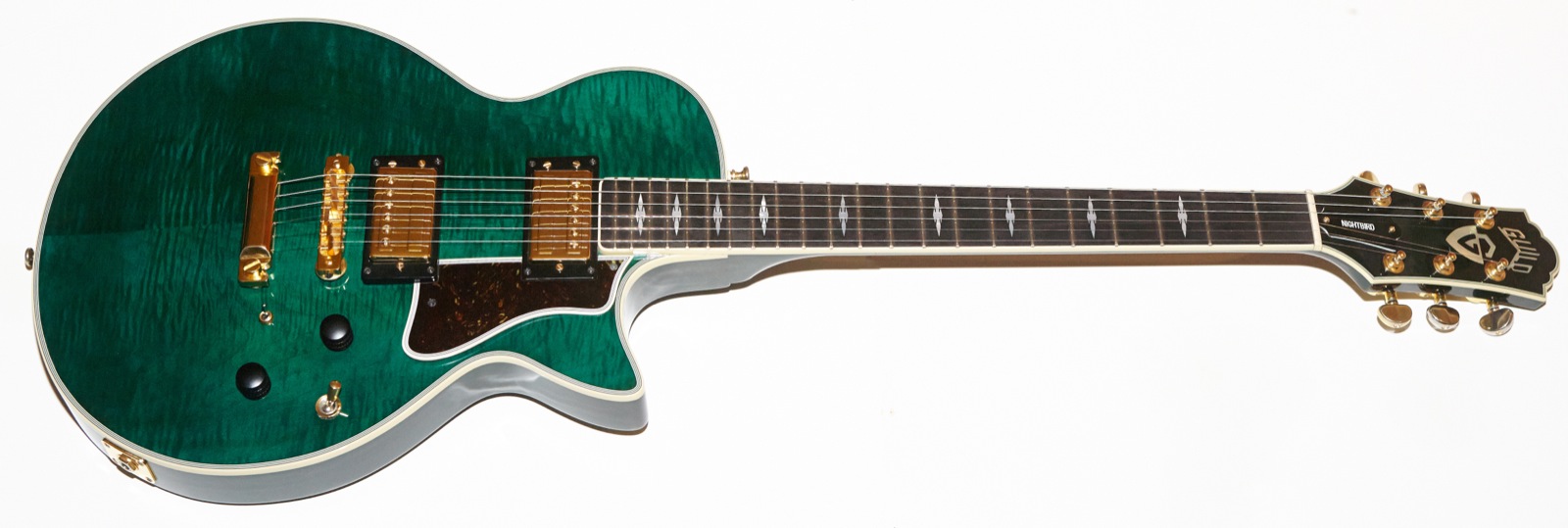

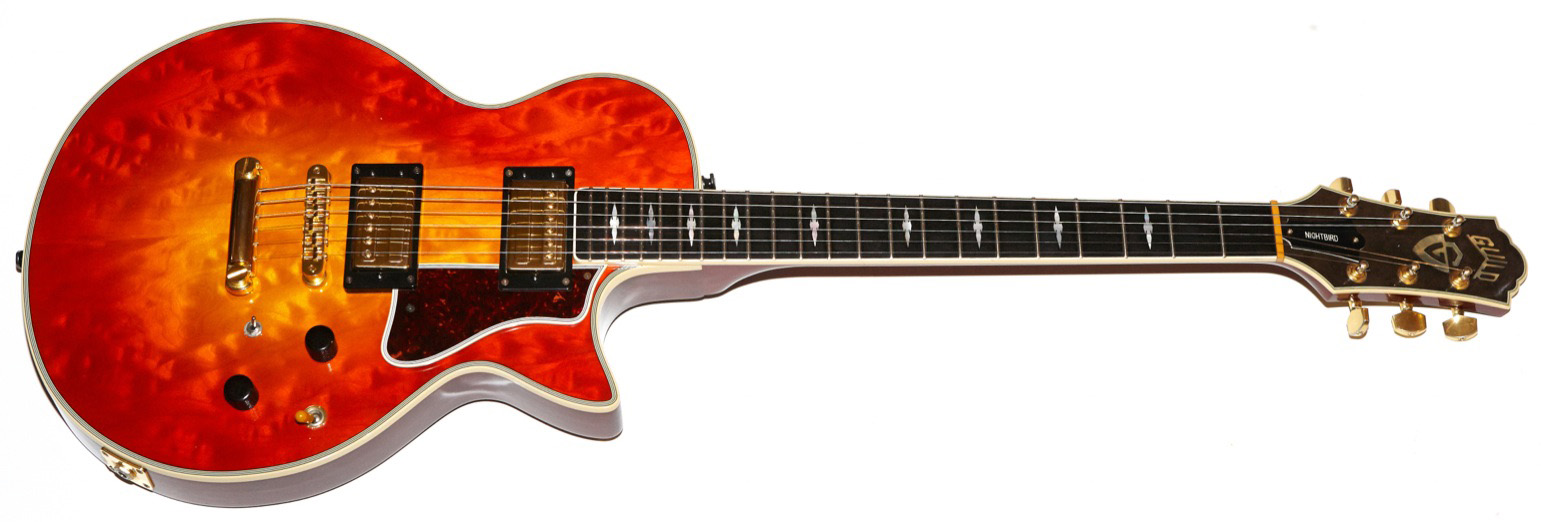
Hi Gary,
my Name is Dietmar, i‘m from Germany. While googeling i have found your site discussing Guild Guitars.
There i found some intersting informations espacially the X2000. I bought one ten or fifteen years ago. It‘s really one of my most loved Guitars. Her colour is transparent red, an absolutely beauty.
If you are interested i can senden you some photos. Let me know.
Kind Regards
Dietmar
I would love to see some photos!
>>>>>>>>>>> I have two Guild X2000. One I custom ordered (in ’93 I think) green CL000050, I still have it. About a year later I bought the last 2 made right after a NAMM show. One was a X2000 with Guild humbuckers, CL000056 amber, I still have it. The other I sold CL000057 but it was anX3000 had an F hole amber and Guild humbuckers.
hope this helps you info
Thanks! I’d love to see a pic of the green one!
I have x2000 #47. How can I send you a photo?
You can email it to gad@gad.net. Thanks!
I need your help. I own one of the very first Nightbirds, serial# BL000026. Though it was built in 1985 I bought the guitar from Guitar Center, Dallas in 1990. At the time of purchase I was unaware that the guitar was 5 years old. It was sold to me as new guitar. I have owned the guitar for 28 years.
Here is my question: Did Guild use fret wire designed with a flat top??
I am asking because a guitar tech recently pointed out that the frets were all flat on top. I can say that the guitar has not been played much and I am certain the condition of the frets have not changed since I purchased the instrument.
I have two theories about the flat frets on my Nightbird:
1). Guild may have used fret wire with a flat top (Gibson experimented with this).
2). When purchased, the guitar was not new and the previous owner had the frets leveled
Hey there – cool history! Is your Nightbird a Spruce top?
As for the frets, I can’t say with certainty without seeing the guitar, but Guild is pretty famous for using low and wide frets that can feel flat compared with the modern trend of very rounded jumbos. This is not a great pic (greatly zoomed and a little out of focus) but it’s the frets on an unplayed Guild X79 from 1982. This is pretty indicative of Guild frets from the ’70s and ’80s: X79-Frets
Hey Gary,
Thank You for the comprehensive overview of the Guild Nightbird.
I purchased one (#BL100205 1986) on recommendation of my guitar instructor in 1991 and absolutely love it.
I do have a quick question though. On all the photos I’ve seen there are two switches: one below the knobs and one above the knobs near the bridge. Mine has just one switch (pick up selector) below the knobs. It looks more like the knob/switches on the Nightbird DX and Standard in your photos.
What do you make of this?
I wouldn’t worry about it. I’ve seen other Nightbirds from that timeframe without the phase switch. Here’s one that was for sale on Reverb:
https://reverb.com/item/1037817-guild-nightbird-gg-1986-black
The prototype didn’t have one, either.
Thanks!
Mine doesn’t have one either I have an 85 nightbird gg Sitka spruce top
Hi Gary,
Great articles on Guild guitars, I’ve learned a lot. I have a Nightbird II, I think, that has a spruce top and the serial number BL100532, slightly outside the range you’ve listed for the 1990 Nightbird II. As you have said, Guild serial numbers are hard to pin down, but I thought you might like to know that the Nightbird II run extended at least through BL100532 – unless it’s a Nightbird CU with a spruce top!
It has black EMG pickups.
I haven’t been able to attach pictures to this email, but can send some if you like, let me know the email address to send then to.
Wow my serial number
Is bl100132 one digit off but mine is a nightbird gg 1985
Good information here, looks like heaven to me. I’ve also had some conversation with Hans in the past; he is the “official” guru, but as far as I am concerned, you provide a nice amount of detail to complete the Guild tapestry. I’ve owned a few Nightbirds, that I unfortunately had to part with. I still have one Nightbird ST serial number LB000020 which according to Hans and yourself is the last one produced. I’ll see if I can post some pictures for you! It’s less than perfect, some small gouges on the back and sides of the headstock, but the slight imperfections only add character, IMHO!
I would love to see that! I have Nightbird DX #20! You anywhere around NJ by any chance? I’d love to take pics of your Nightbird ST.
Hi Gary,
I just purchased #BL100498. Does that ring any bells? It’s the “lava burst” Nightbird II (or Custom?) at the top of your post. I’ve wanted a Nightbird since I first saw an ad for one in Guitar Player magazine back in 1987, and I am so pleased to have found such a nice example. It is currently in transit with UPS, and I can’t wait to play it!
Great blog, by the way!
Congrats! I have a complete review of that guitar that’s been almost done for over a year. Maybe you’ll see it in its own article soon! It’s a fabulous guitar.
I have a 87 Night Bird II which I bought new. I’d sell.
Hi
Friend of mine as a very nice Guild X-2000.
I would like to send you pictures in order you give me some information about this model and to show you a late X-2000 (I think) with a pick-guard and PAF type Humbucker.
could you give me your email adress please.
Thanks
Best regards
Michaël
Email sent
Hi Gary,
the serial number range for the X2000 must be wrong. Because mine ends with 58!
It is a cherry sunburst maple top with zebra pick ups. I once got it from a friend at Fender Europe.
Greetings from Austria
Stephan
Thanks for posting! I have an X2000 that’s #56, but now yours is the highest number I’ve seen.
Would you like to have a photograph of the serial number?
That’s not necessary, but thanks!
Hi Gary, just re-reading your wonderful account of the Nightbirds. I just bought the body blank that has been on Reverb for ages from Germany, I’m sure you’ve seen it. It was a triple pronged purchase – first I’ve always fancied a Nightbird, but couldn’t stump up the $5K+ for Dinar, and 2nd I have a rather beautiful set of unused original Joe Barden 2 Tone humbuckers (I was the UK importer for them in the 90’s) that I really wanted to use rather than sell and I thought they would work where EMG had once, and Third I have recently reconnected with Robbie Gladwell (Dr Robert in Guitarist Mag for years, an ex Gibson employee, and Suzi Quatro’s guitarist amongst others) who lives near to me in Suffolk.
The upshot is I’m going to initiate a project with Robbie for fun (I’m a classical guitarist and teacher mostly) to build a new Nightbird with the Joe Barden’s in it.
I thought I would ask about neck specs as we are doing a neck from scratch. Did the neck dimensions vary much over the years? I’m an arch top lover, not into skinny necks for reasons both touch and tone, and would be grateful for any advice you might have on authentic neck specs for Nightbirds.
(Hope my project doesn’t seem a waste to you – I really love the design of the Nightbird and was anxious to turn even a rejected body blank into something approaching that beauty.)
BTW I have a small collection (7) of Guild hollowbodys which Hans has helped me identify and contextualise.
Very best regards and thanks for your work on Guilds!
Tim
That sounds amazing! I’d love to see pics of it when you’re done!
As for the necks, the Nightbird I had one of the thinnest necks ever while one of my Nightbird IIs has a very fat neck. Since you’re building from scratch (sort of) I’d make the neck exactly the way you like it! Here are the specs from one of my Nightbird IIs: 1st, 5th, 7th, 12th fret depth: .80″, .83″, .84″, .88″. Width at same frets: 1 23/32″, 1 29/32″, 1 31/32″, 2 3/32″. Radius: 12″. Generally C-shaped. Hope that helps!
Wonderful thanks for the help and encouragement! Keep you posted. Tim
Hi !
i’ve the chance to own an X2000.
Mine is blue and #3. Bought it from vintagemaster in Switzerland few years ago.
Best regards
JB
Hello from Finland
I have X2000 w serial #CL000003
– sunburst
– and I got it from Switzerland
– would you please recheck your serial number?
Thank you.
Greetings Gary! I am Eugene from the Philippines and I was lucky to have acquired A 1987 Nightbird 1 wih the OHSC. I applied a paisley decal over the black top just to have some fun without destroying the original finish when I go back to my senses 🤣. Also changed the pickup covers to chrome and attached skull knobs.Anyway, I had a problem with the plastic cover for the electronics (See pics). I am not sure if it was due to the tropical climate but it disintegrated and sort of caused an acid reaction which corroded my pots! My two questions are:
1. What kind of material did they use for the tort covers/ pickguard?
2. If my pots are damaged, what should I replace them with? I don’t have info on the specs.
Hey there!
The original back plates were made of cellulos which would off-gas and destroy nearby metal. This was a problem with many guitars going back decades, believe it or not. See sample pics in this thread: https://www.jazzguitar.be/forum/guitar-amps-gizmos/55265-all-old-pickguards-doomed.html
As for values, if it’s truly a Nightbird I you can see the specs in my article here: https://www.gad.net/Blog/2018/01/07/guild-nightbird-i/
Dan Rose
I purchased an 86, serial #BL100026, from Johnny Red in Ft Worth in about 1992. Is still in excellent condition, spruce top, tobacco sunburst, Seymore Duncan pickups, “black chrome” hardware. A gem!!
Finally found an article on my old Guild Nightingale! I bought in the late 80s at a music store in Merrick NY for $250. Purple or blue burst with EMGs and black hardware. Loved that guitar. Had to sell it to pay bills in El Cajon, Ca. Back then as in today( just took a pawn loan on my three best to pay house taxes. The joys of living off of SSD) you sold best gear for a better return . Recently been thinking about the guitar, and for some reason thought it was a Burnside, but nothing came up that matched. With a little more digging I found it! I hope to get one to play and pass on to others who enjoy it.
Hey there – if you paid $250 for the guitar it was not a Nightingale since they had a list price of $1495 in 1988, so a Burnside is more likely if your memory of the price is correct. Are you sure it was single-cut like the Nightingale? The only single-cuts I’m aware from Burnside of are Tele-shaped, but I’ve seen some Burnside models over the years that are not in the catalogs I have. There was a model named the Mini Starfire but it was double-cut.
Thanks Gary!
I have referred to your article many times over the last few years.
I actually confirmed that my beloved Amber Nightbird (BL100205) that I purchased in 1991 from a shop on recommendation of my then guitar instructor is indeed a 1986 original.
I could not sort out why mine did not have the coil tap toggle when all the other elements Mueller gold bridge, diamond inlays, bindings, Gotoh Wafflebacks, etc. seemed in place.
Your article and a conversation with George Gruhn on 2/23/22 (!) confirmed its model, year of manufacture, and options.
Thanks Again,
Ray
Glad it could be a help!
Hi,
I own a Nightbird type 1 (entry level) 2-1988 (serial number BC1000091), bought new in 1991.
I hated the sharp flat frets and had it refretted and a bit customized by the locally (Holland) famous Hans Pluut, who made two little chamfers at the extremities of the fingerboard as to deminish the too prevailing ‘uneven harmonics’ and who changed the upper pick-up for a Seymour Duncan. The sound has become much better and the instrument plays ‘on its own’. If you like, I can mail you some detailed photographs.
GAD, and others,
I have a Nightbird with a cracked pickup bezel. EMG pickups. Is there a source for a replacement bezel?
Mark
Hey there. You best chance is either of these two:
Hans Moust: http://www.guitarchives.nl/guitarsgalore/
Ken Nash: http://www.theguitarmechanic.com/Guildparts.html
Good luck!